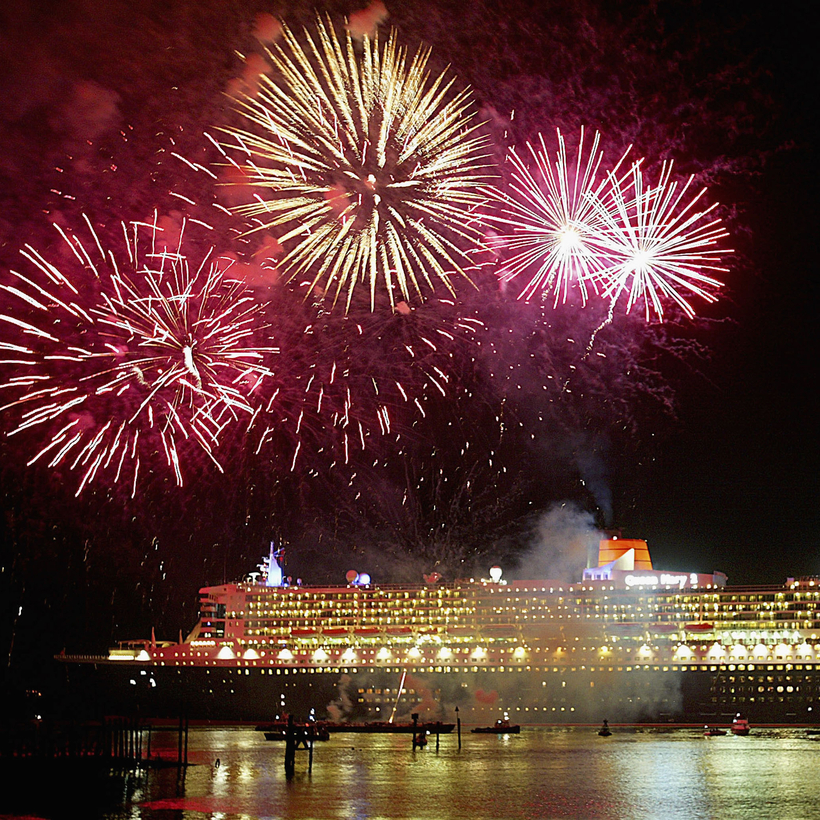I traveled from London to New York in November of 2019 and December of 2022. The westbound legs took eight hours, 15 minutes each by the traditional airborne method. The eastbound return journey? Seven days and seven nights each time.
It takes only seconds to send an e-mail from what we used to call the New World to the Old World. A few days more for snail mail. But I will willingly give up one week to get from A to B, from N.Y. to U.K., and this is why.
If you have world enough, and time, this is the most civilized, fun, and leisurely way to trans the Atlantic. (My journey was comped, as I gave several talks on board, but rates for the Princess Grill suites, which are at least 300 square feet, run from $2,000 to $3,000 for the entire seven-night crossing. It’s not outrageous, given the cost of air travel these days.) Put the Queen Mary 2, with its deep-navy-blue hull and bright-red funnel, on your bucket list now—it’s the nippiest merchant ship in service today.

There’s not really a bad time of the year to attempt this voyage, but I am preferential to November to December, during the annual Times and The Sunday Times Cheltenham Literature Festival at Sea. At the 2022 event, I was just a small-fry speaker, but more familiar names abounded. Among the big fish in our presence: classicist Mary Beard; novelists Lionel Shriver, Rachel Joyce, Alexander McCall Smith, and Okechukwu Nzelu; polymath Simon Winchester; and former politician and current national treasure Ed Balls.
If you want to buttonhole a prizewinning author on the companionway or listen to the poet laureate recite Dylan Thomas (which Simon Armitage kindly did for my husband’s 70th birthday, which took place on our sixth day on the high seas), then this is the crossing for you. You can’t get your steps in on the promenade deck without bumping into at least one Booker Prize winner. Bernardine Evaristo, for example.

It must be the grandest as well as the fastest ocean liner in service—all lofty lobbies with bronze reliefs, silver-service restaurants, theaters, ballrooms, and even a planetarium, and it’s done in a swaggering haut confort style. The authors converged on the lounge-lizard bar called the Commodore Club for cocktails every night in our glad rags, and it was no surprise to hear that the Queen Mary 2 was christened by another Queen, Elizabeth II, and has borne Rod Stewart, Carly Simon, Dave Brubeck, and many other notables. She even hosted prime ministers and presidents when she berthed in Piraeus as a floating hotel for the Athens Olympics in 2004, the year of her maiden voyage.
This is how it goes: After embarkation in Brooklyn, your trunk is placed in your “state room”—that’s Cunard for “cabin” with a balcony—by willing hands. (Ours was mid-range with a balcony, but you can go mad and splash out on a Queens Grill suite for about twice the price.)

In time, you go to the stern for the “sail away.” At sunset, the horns are sounded and the great ship steams away from a sparkly, twinkling New York to the sound of chiming bell buoys. It soon scrapes under the Verrazzano-Narrows Bridge. That’s the only solid thing you will see—apart from the odd container ship—for days on end.
But there are ways to pass the time. Eating, for starters. The ship’s meal service happens four times each day—breakfast, lunch, dinner, and the silver-service three-course cream tea (sandwiches, scones, and cake), doled out from 3:30 p.m. by a procession of white-gloved waiters.

Now, about the packing. All this revelry adds up, and habitués of the high seas know that it is necessary to pack two wardrobes: one for the start of the crossing, and a second, less constrictive set you can ease into at the end. On at least one night, you will be required to wriggle into a Gatsby-esque flapper dress or black-tie for the “Roaring 20s” dinner. All the other evenings will require “smart” attire.
Even for those who overdid it on the Negronis, quality shut-eye came easy, thanks to the sea air and rocking motion of the vessel. The Queen Mary 2’s mattresses are so comfortable that Sealy does a roaring trade in selling the Cunard to customers (not the used ones). You can even bring your pet—during my December voyage, there were 12 of them on the boat (with capacity for 24, but dogs and cats only, please).

Do make sure your travel and health insurance is comprehensive and watertight. Just in case the worst comes to pass, there is a fully equipped medical center and morgue on board. On the second day of my journey, a helicopter landed on the ship in order to perform a casevac (casualty evacuation). The rumor is that when the four-body morgue is full, everyone is offered ice cream, as the crew just might need to store the excess corpses in the deep freezes. Those are located along “Burma Road,” a long corridor cleaving the service deck of the ship, where the storage areas, kitchens, 21 refrigerated rooms, and staff quarters are all located. (There is even a pub called the Pig & Whistle, which services about 1,250 crew members.)
I became morbidly fascinated by the notion of death on the Atlantic crossing. So I brought it up with our captain, Aseem Hashmi. “Given there are two and a half thousand passengers on board, and given the age and, er, weight profile of a proportion of the guests, there must be at least two deaths a crossing?,” I asked. Captain Hashmi said it was more like one or two a year, and then told me the average age of passengers on that crossing was a sprightly 64. That sounded about right. My 2,691 fellow passengers included families with small children (there are several pools) as well as silver surfers and cruiseaholics.

“What about births?,” I asked. The captain said he’d had only one of those in his 37-year career—“brought on at seven months by rough seas,” he explained. But, he confessed, he had personally conducted three weddings that very week! Other rituals include his midday maritime briefing, which involves an amusing but not alarming anecdote, and an homage to the Titanic: every time the ship passes over its graveyard, a bell is tolled, and people shiver.
The clocks are moved forward one hour each day, so upon disembarking at Southampton, it’s the softest of landings. But it does take a while to get used to walking on solid ground rather than rolling teak; you may stagger around like a drunken sailor for days.
As the Queen Mary 2 closed in on the west of England after a week at sea, I bumped into Armitage outside my state room. “The atmosphere,” the poet laureate said, abstractedly, his fringe flopping over his eyes. “It’s like The Shining at sea.... Look down there.” He pointed down the deck. “It’s so long.... At the end of that corridor you can almost see mist.” On both occasions, some celebrated writer declared their intention to write a murder mystery, a maritime whodunit, but nobody has published one quite yet. There’s still hope that Richard Osman, author of the best-seller The Man Who Died Twice, will prevail. He’s already booked for the 2023 edition of the Literature Festival at Sea.
Some enjoy the experience so much that they give up the airplane entirely. The writer A. L. Kennedy, who doesn’t fly, was apparently on my journey, but I never saw her, as she was squirreled away in her cabin. She probably writes thousands of words before breakfast, but, then again, you can write (or, in my case, not write) thousands of words before breakfast at home, any day. You can only drink cocktails in the Commodore Club on the Queen Mary 2.
I know which kind of crossing I prefer.
Rachel Johnson is a journalist and author. Her books include The Mummy Diaries, Notting Hell, and Rake’s Progress: The Madcap True Tale of My Political Midlife Crisis


